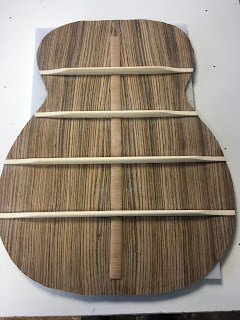The front bracing is much more complicated than the back, which is why I did the back first!
The plans in the Kinkead book are very comprehensive and full size - you need to transfer the positions of each brace onto the inside face of the top.
There are a few ways to do this but I opted to photocopy the plans, then tape the four A4 sections together into 1 piece, before cutting small slots at the end of each brace position with a craft knife, so I could mark through onto the wood.
After taping the plan onto the back (using the soundhole and centreline as datums), it was easy to mark the ends and then "join the dots" to transfer all of the positions across. (Remember, the top plate is oversize at this point - it will be trimmed down to it's final shape and size after being joined to the sides.)
The front is given a two dimensional camber by forming the surfaces of the main braces into gentle convex curves with a relief of up to about 3mm. This was done in the same way as for the back braces.
Then the lap joint needs to be formed for the main cross bracing. By laying out the two pieces on the plans, I could mark the junction and cut the notch out of the bottom half. Then, by letting the top half into the rebate I had cut, I could mark the matching rebate in the top bracing so that the correct intersection angle was formed.
I glued the joint and then smoothed the joint face down so that the glueing surface was flush against the soundboard. Then I could lay out the rest of the braces to check all of the positioning was right.
I pre-formed the chamfered ends on each of the braces using the belt sander. I also formed small notches where each of the finger braces intersects the main braces to help them locate firmly. You can just see them in this picture below - they are only 2mm deep but will really help to lock the whole "system" of bracing together.
If I was building lots of guitars, I could build an elaborate, cambered jig to glue all of the bracing at once. But my "shed at the bottom of the garden" method was to glue the main, pre-cambered braces first, so that the soundboard took on the dome shape, and then glued the finger braces in 3 or 4 successive stages. I guess that the camber might not be quite as precise this way but it feels like a 1% difference thing to me.
The photos below show the flat bracing plates being glued around the soundhole and above the main brace.
Finally I glued a small capping across the X-brace joint. This puts back the strength that is lost from this critical area by forming the lap joint. Some guitars use a glued linen patch at this point but I liked the idea of a cohesive carved arch.
This is the soundboard after all of the bracing is installed. The only part still to glue on is the bridge plate - I'm waiting for some maple to be delivered to make this.
The next part was exciting and scary in equal measure! Carving the braces to their final shape. I have followed the plans closely for this, although an experienced luthier would be guided by the "tap tone" of the wood as successively more wood is removed. With my wonky hearing, I doubt that I could discern any difference!
I used a combination of chisels and block plane. Most of the braces were 2-3mm higher than their design height, so there is a fair amount of wood to remove. The pictures tell the story really.
Once the rough shapes were formed, I used progressively finer grades of sandpaper to form the final shapes.
So now I have both top and bottom completed. The next scary instalment is the bending of the sides 😰.






























































